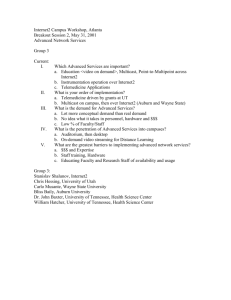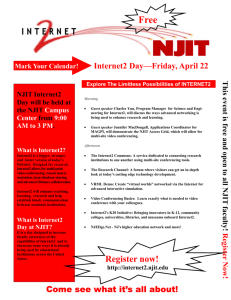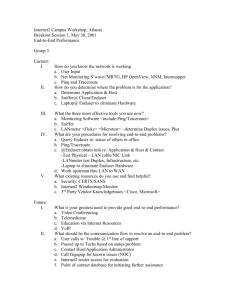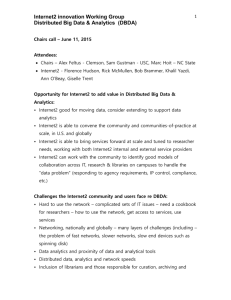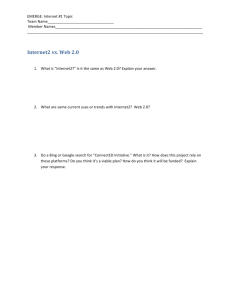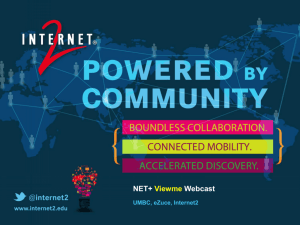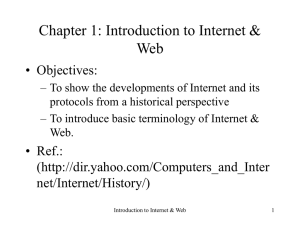Internet2 Setting Description, abridged
advertisement
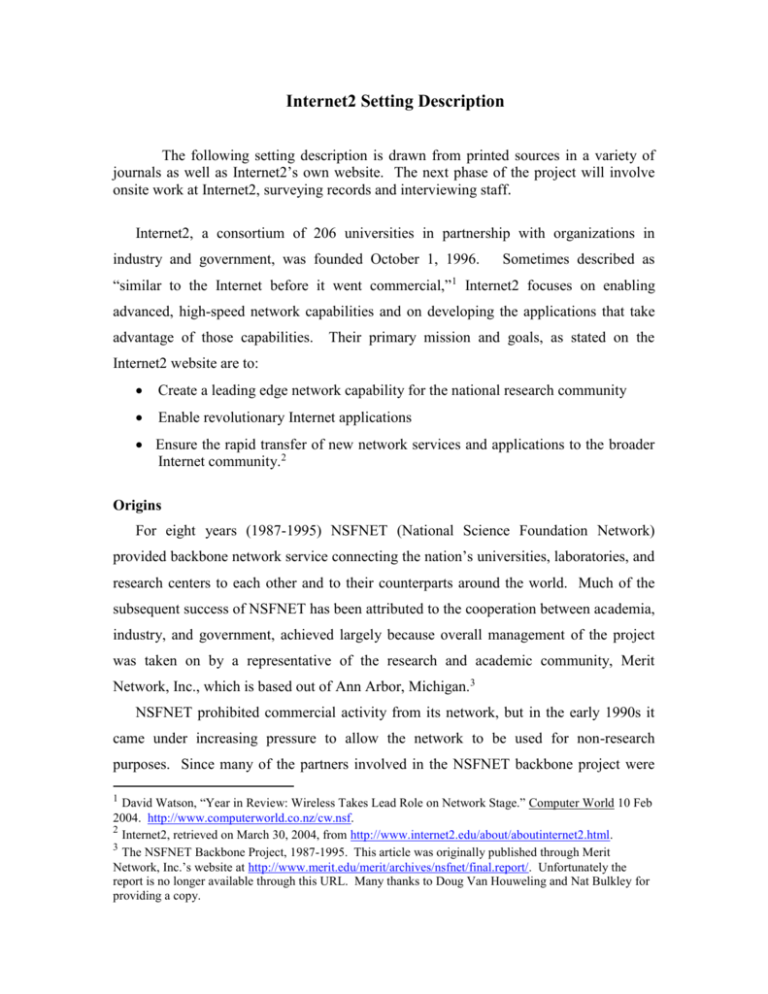
Internet2 Setting Description The following setting description is drawn from printed sources in a variety of journals as well as Internet2’s own website. The next phase of the project will involve onsite work at Internet2, surveying records and interviewing staff. Internet2, a consortium of 206 universities in partnership with organizations in industry and government, was founded October 1, 1996. Sometimes described as “similar to the Internet before it went commercial,”1 Internet2 focuses on enabling advanced, high-speed network capabilities and on developing the applications that take advantage of those capabilities. Their primary mission and goals, as stated on the Internet2 website are to: Create a leading edge network capability for the national research community Enable revolutionary Internet applications Ensure the rapid transfer of new network services and applications to the broader Internet community.2 Origins For eight years (1987-1995) NSFNET (National Science Foundation Network) provided backbone network service connecting the nation’s universities, laboratories, and research centers to each other and to their counterparts around the world. Much of the subsequent success of NSFNET has been attributed to the cooperation between academia, industry, and government, achieved largely because overall management of the project was taken on by a representative of the research and academic community, Merit Network, Inc., which is based out of Ann Arbor, Michigan.3 NSFNET prohibited commercial activity from its network, but in the early 1990s it came under increasing pressure to allow the network to be used for non-research purposes. Since many of the partners involved in the NSFNET backbone project were 1 David Watson, “Year in Review: Wireless Takes Lead Role on Network Stage.” Computer World 10 Feb 2004. http://www.computerworld.co.nz/cw.nsf. 2 Internet2, retrieved on March 30, 2004, from http://www.internet2.edu/about/aboutinternet2.html. 3 The NSFNET Backbone Project, 1987-1995. This article was originally published through Merit Network, Inc.’s website at http://www.merit.edu/merit/archives/nsfnet/final.report/. Unfortunately the report is no longer available through this URL. Many thanks to Doug Van Houweling and Nat Bulkley for providing a copy. private corporations with no need for a research or education network, they soon devised a plan for the transfer of responsibility for the nationwide backbone service. As one person on the project stated, “It had to come…because it was obvious that if it didn’t come in a coordinated way, it would come in a haphazard way, and the academic community would remain aloof, on the margin…There had to be commercial activity to help support networking, to help build volume on the network.”4 According to the NSF, “commercial use of the network…would further the objectives of NSFNET, by enhancing connectivity among commercial users and research and education users and by providing for enhancements to the network as a whole.”5 All this meant, however, that the research community suddenly had to share its private network with thousands, and later millions, of new users clogging the system, slowing it down, and making it increasingly difficult for research institutions to use the network for the kinds of advanced applications they felt they needed. Enter Internet2 In the fall of 1996, 34 universities met in Chicago to form Internet2, an initiative started to address the founders’ concerns that the commercial Internet lacked leadership in providing the advanced networking required of research institutions.6 The project would be financed through membership fees, and like NSFNET, would be dependant upon the cooperation and investment of industry and government. The main universities leading this project at the time were Pennsylvania State, Stanford University, and the Universities of California, Chicago, Michigan, and North Carolina. According to one supporter, “The new network would solve the same "chicken-and-egg problem" that the NSFNET had addressed: Telecommunication companies will not make the next generation of network technology available unless there is a critical mass of potential customers, plus some demonstrations of what can be done with the technology.”7 4 Ibid. Ibid. 6 Eric M. Aupperle., “Merit: Who, What, and Why.” Library Hi Tech, Vol. 16, no 1 (1998): 35. 7 Thomas J. Deloughry, “Computing Officials at 23 Universities Seek to Create a Network for Higher Education.” The Chronicle of Higher Education 43:7 (1996): A29. 5 In 1997, as more institutions were joining Internet2, it became incorporated as the University Corporation for Advanced Internet Development (UCAID), and Douglas Van Houweling, who served on the Board of Directors for Merit Network, Inc. and as ViceProvost of Information Technology at the University of Michigan, became its first CEO and President. Internet2 Today Today, Internet2 is known internationally as a pioneer in advancing next generation Internet technologies and bringing those capabilities to the higher education and research community. Although it began with only 34 university members and corporate membership that represented primarily telecommunications and computer companies, Internet2 is now made up of a large and diverse membership that includes 206 universities and corporate and affiliate membership drawn from the fields of manufacturing, pharmaceuticals, and the arts. Membership and Partnerships Internet2 has four main types of membership: Regular, Affiliate, Corporate, and the newly added Association. Regular membership is limited to higher education institutions and currently has been granted to 206 universities in the U.S. To become Regular Members universities must pay membership fees of $27,000 per year as well as commit to upgrade their campus network connections and use and develop Internet2 support applications. The estimated cost of upgrade is $500,000 dollars per campus per year. Affiliate membership is open to non-profit and research institutions across the country. Affiliates are required to pay $10,800 in membership fees, and to become “collaboration” sites, which would allow them to connect to Internet2’s high-speed backbone network, Abilene, they must pay an additional $27,000 per year. Currently there are 41 affiliate members, which include NASA, NARA (the National Archives and Records Administration), and the FDA (the Food and Drug Administration). Corporate membership is subdivided into three categories: Regular, Corporate Partners, and Corporate Sponsors. All three types pay an amount, between $11,000 and $27,000, based upon their annual revenue. There are 41 Regular Corporate Members including Apple, Comcast, General Motors, and Pfizer. Corporate Partners must pay an additional $1,000,000 in goods and services over three years. The 15 Partners currently working with Internet2 include AT&T, IBM, MCI, and Qwest Communications. Corporate Sponsors agree to contribute an additional $100,000 or more over a threeyear period. BellSouth, Ford Motor Company, and ArborNetworks are some of the 10 Corporate Sponsors currently involved with Internet2. Internet2’s recently established Association Membership is intended for non-profit research and education associations with national or international scope. These associations must have dues paying members, and the majority of associations’ members must also be non-profit organizations. Besides these, other non-profit consortia that focus on advanced technologies for research and education may also be considered on a case-by-case basis. If associations wish to connect to Abilene, however, they must become Affiliate Members with Collaboration Site status. Association Members pay annual dues of $2500, and although there are no members in this category yet, examples of qualifying associations are the National Association of College and University Business Officers (NACUBO), EDUCAUSE, the Association for Communications Technology Professionals in Higher Education (ACUTA), and the Global Grid Forum (GGF). In addition to the primary categories of membership discussed above, Internet2 has also formed partnerships with international and government organizations that have similar goals as Internet2. Interested international organizations must complete a Memorandum of Understanding (MoU) which is the international organization’s commitment to work together with Internet2 to develop advanced networking technologies and applications for education and research communities. There are currently 45 such organizations spanning North and South America, the Middle East, Europe, and Asia and the Pacific Rim. Internet2’s interest in developing advanced network applications aligns with several government initiatives and programs. The federal government plays a key role in supporting some key technological developments as well as works in cooperation with universities exploring cutting edge network technologies. The Next Generation Internet (NGI), announced just 7 days after Internet2 formed, is a federal government initiative for the development of advanced Internet applications and technologies, and many of the government agencies that have worked with NGI, including the National Science Foundation, the Department of Energy, National Institutes of Health, NASA Department of Defense, and the National Institute of Standards and Technology, are also involved with Internet2. Additionally, there are a number of projects and organizations that Internet2 is heavily involved with either as project leader or co-collaborator. These include the 100 x 100 Project, HOPI (The Hybrid Optical and Packet Infrastructure Project), FiberCo (National Research and Education Fiber Company), TeraGrid, Global Lambda Integrated Facility (GLIF), National LambdaRail, Inc. (NLR), and PlanetLab. The 100 x 100 Project is an NSF funded collaboration between researchers at Carnegie Mellon University, Fraser Research, Rice University, the University of California at Berkeley, Stanford University, Internet2, the Pittsburgh Supercomputing Center, and AT&T Research. Together, they are working to rebuild the nation’s Internet architecture so that it can support higher network speeds for homes and small businesses.8 HOPI is led by Internet2 and is part of their effort to develop a hybrid optical and packet infrastructure for the Internet. This project is central to Internet2’s mission to “provide scalable, sustainable, high-performance networking in support of the research universities of the United States.”9 Internet2 started FiberCo to ensure that the research and education community maintains access to a “strategic fiber acquisition capability on a national scale.” The access to dark (unlit) fiber will help Internet2 continue to develop and maintain advanced network capabilities and applications.10 TeraGrid, another NSF project, is working to develop and deploy “the world's largest, fastest, distributed infrastructure for open scientific research.” Five sites will be part of this network, and Internet2 is working with other organizations to build some of the 8 Retrieved on April 16, 2004, from http://www.internet2.edu/about/related-projects.html#nlr. Ibid. 10 Ibid. 9 middleware architecture for the TeraGrid. Internet2 also plans to allow members to tap into the TeraGrid’s resources through their high-speed backbone network, Abilene.11 The Global Lambda Integrated Facility (GLIF) is a “world-scale Lambda-based Laboratory for application and middleware development on emerging LambdaGrid.” Lambda Grids depend on optical networking, which sends information as light waves instead of as electricity or radio waves. Internet2 is contributing to this project by participating in lightwave experiments at the Manhattan Landing.12 Internet2 plans to donate over $10million in the next five years to National LambdaRail, Inc. (NLR), an initiative of research universities as well as private sector technology companies to create the world’s largest higher-education owned optical network and research facility. Internet2 also serves on NLR’s governance board and has permission to use one of NLR’s 10gbps wavelengths when it begins operations.13 Conducted in the Abilene Observatory, PlanetLab is a collocated research project that connects researchers and allows them to run software on many computers at once, creating, in effect, “a large, widely distributed computer.”14 Nature, Scale, and Scope of Production Bandwidth is considered the key ingredient in the advancement of new network technologies capable of serving education and research. Examples of applications that depend on high-bandwidth capability are video conferencing, multicasting, and the transfer of large amounts of data characteristic of scientific research. Internet2 is committed to creating and maintaining a high-bandwidth, low-latency network and developing the applications that take advantage of the high capacity network. The main categories of development work at Internet2 are divided into five main categories: Initiatives, Applications, Engineering, Middleware, and Networks. Although Internet2 employs approximately 80 persons on its staff, much of the development work of the organization is carried out by Working Groups, Advisory 11 Ibid. Ibid. 13 Ibid. 14 Ibid. 12 Groups, and Special Interest Groups. Working Groups are the main mechanism for architecture, design, and implementation of Internet2 innovations. Initiated primarily through Area Directors, individuals, or groups of individuals, these groups form around a particular area of development and then disband when work is completed. Currently there are 21 Working Groups, covering such areas of development as digital video, voiceover IP, IP optical, and various middleware projects. An example of a specific innovation developed by a Middleware Working Group is Shibboleth, a piece of software that facilitates the sharing of web-based, password protected resources between organizations. If a user is authenticated at one institution, s/he is granted access based upon registration with that site, rather than having to login again. A Shibboleth deployment at Penn State in January, 2004, allowed thousands of authenticated students to register for Napster’s music sharing service. Governance Structure While we must still collect more detailed information about Interent2’s governance structure and decision-making processes, we were able to cull a basic outline from the Internet2 website. Internet2 is governed by a Board of Trustees, which is made up primarily of university presidents from member institutions. The Board always numbers between 3 and 13 and currently has 12 members. The Board is responsible for making the decisions of Internet2 and does so by majority vote. Four Advisory Councils, created by Board of Trustees resolutions, advise the Board on issues related to advanced networking in higher education. The President and CEO of Internet2, Doug Van Houweling, serves as the main point of contact between the Board and all outside organizations. He is responsible for recruiting and discharging employees and must also carry out the plans, programs, and budgets decided upon by the Board. The Working Groups are committees ruled by rough consensus. They are relatively independent from Internet2 in terms of how they are governed, but must still each have an Area Director (a member of Internet2 staff), who oversees the groups. Each Working Group has one or more Chairs who are responsible for group management, planning group sessions, as well as ensuring that the mission they outline in their charter is completed.
